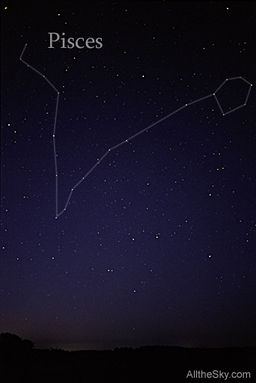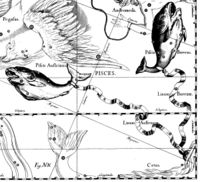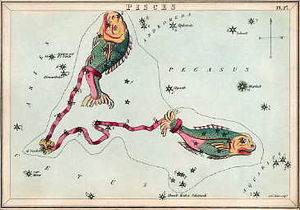Pisces (constellation)
| Constellation | |
List of stars in Pisces |
|
| Abbreviation | Psc |
|---|---|
| Genitive | Piscium |
| Pronunciation | /ˈpaɪsiːz/, genitive /ˈpɪʃiəm/ |
| Symbolism | the Fish |
| Right ascension | 1 h |
| Declination | +15° |
| Quadrant | NQ1 |
| Area | 889 sq. deg. (14th) |
| Main stars | 21 |
| Bayer/Flamsteed stars |
86 |
| Stars with planets | 7 |
| Stars brighter than 3.00m | 0 |
| Stars within 10.00 pc (32.62 ly) | 8 |
| Brightest star | η Psc (3.62m) |
| Nearest star | Van Maanen's Star (14.07 ly, 4.31 pc) |
| Messier objects | 1 |
| Meteor showers | Piscids |
| Bordering constellations |
Triangulum Andromeda Pegasus Aquarius Cetus Aries |
| Visible at latitudes between +90° and −65°. Best visible at 21:00 (9 p.m.) during the month of November. |
|
Pisces is a constellation of the zodiac. Its name is the Latin plural for fish, and its symbol is ![]() (Unicode ♓). It lies between Aquarius to the west and Aries to the east. The ecliptic and the celestial equator intersect within this constellation and in Virgo.
(Unicode ♓). It lies between Aquarius to the west and Aries to the east. The ecliptic and the celestial equator intersect within this constellation and in Virgo.
Contents |
Notable features

The Vernal equinox is currently located in Pisces, due south of ω Psc, and, due to precession, slowly drifting below the western fish towards Aquarius.
Van Maanen's Star, at 12.36 magnitude, is located in this constellation.
Pisces contains one galaxy that is listed in Charles Messier's catalog, named the spiral galaxy Messier 74.
Asterisms and subdivison
- This was an obsolete constellation located between the constellations of Pisces and Cetus, today constituting a natural but faint asterism, where the star 20 Psc is intended to be the head of the turtle. The origin of the constellation is uncertain, but it is alleged that it was proposed by an astronomer Admiral Smyth on his book[3] in the middle of 19th century. It is no longer recognized.[4]

- Piscis Boreus (the North Fish)[5]: σ - 68 - 65 - 67 - ψ1 - ψ2 - ψ3 - χ - φ - υ - 91 - τ - 82 - 78 Psc.
- Linum Boreum (the North Cord)[5]: χ - ρ,94 - VX(97) - η - π - ο - α Psc.
- Linum Austrinum (the South Cord)[5]: α - ξ - ν - μ - ζ - ε - δ - 41 - 35 - ω Psc.
- Piscis Austrinus (the South Fish)[5]: ω - ι - θ - 7 - β - 5 - κ,9 - λ - TX(19) Psc.
- Pisces represented above 4 subdivisions in Hevelius' star map.
- The Circlet: γ - 7 - θ - ι - TX - λ - κ,9 Psc.
Mythology and visualizations

The constellation is commonly represented as two fish, each of which is tied to the same point by a long length of string. The fish are connected at the tails. However, the 'strings' can also be interpreted as stick-figure men (with the 'fish' thus becoming their heads), and some forms of early Greek mythology viewed it as men bound to a point, with only the constellation Piscis Austrinus considered to be a fish.
According to one Greek myth, Pisces represents the fish into which Aphrodite and her son Eros transformed in order to escape the fire god Typhon; they are tied together with a cord on their tails, to make sure they do not lose one another.[6] Alternatively, the twin fishes were placed in the heavens in honor of their heroic deed of saving Aphrodite and Eros from Typhon on the river Euphrates.
Babylonian
The constellation Pisces and the astrological sign Pisces share a fish symbol. According to J. H. Rogers the fish symbol originates from some composition of the Babylonian constellations Zibatti-meš (maybe Šinunutu4 "the great swallow" in current eastern Pisces) and KU6 ("the fish, Ea", Piscis Austrinus). The constellation then went under the name DU.NU.NU, Rikis-nu.mi, "the fish cord"[7]. Rogers thinks this constellation was somehow misinterpreted and turned around so that the current northern fish is on the border of Andromeda, instead of being constituted by Piscis Austrinus.
Astrology
While the astrological sign Pisces per definition runs from ecliptical longitude 330° to 0, this position is now mostly covered by the constellation of Aquarius, due to the precession from when the constellation and the sign coincided. According to new agers and some tropical astrologers, we are currently in the Age of Pisces,[8], while other maintain that we are in the Age of Aquarius.
As of 2002[update], the Sun appears in the constellation Pisces from March 12 to April 18. In tropical astrology, the Sun is considered to be in the sign Pisces from February 20 to March 20, and in sidereal astrology, from March 15 to April 14.
References
- ↑ Allen, R. H., (1963). Star Names: Their Lore and Meaning (rep. ed.). New York, NY: Dover Publications Inc.. p. 163 342. ISBN 0486210790.
- ↑ Ciofi, C., Torre, p., Costellazioni Estinte (nate dal 1700 al 1800): Sezione di Ricerca per la Cultura Astronomica
- ↑ Smyth, W. H., (1884) The Bedford Catalogue
- ↑ Horvatin, S., Testudo, the turtle: obsolete constellations
- ↑ 5.0 5.1 5.2 5.3 Hevelius, J., (1690) Firmamentum Sobiescianum, Leipzig, Fig.NN
- ↑ Star Tales – Pisces
- ↑ Origins of the ancient constellations: I. The Mesopotamian traditions by J. H. Rogers 1998, page 19 page 27
- ↑ Nicholas Campion, The Book of World Horoscopes
- Ian Ridpath and Wil Tirion (2007). Stars and Planets Guide, Collins, London. ISBN 978-0007251209. Princeton University Press, Princeton. ISBN 978-0691135564.
- Richard Hinckley Allen, Star Names, Their Lore and Legenc, New York, Dover: various dates.
- Thomas Wm. Hamilton, Useful Star Names, Holbrook, NY, Viewlex: 1968.
External links
|
||||||||||||||
|
|||||
|
||||||||||||||||||||||||||||||||
| Astronomy | Constellations of the Zodiac |
|---|
| Pisces ★ Aries ★ Taurus ★ Gemini ★ Cancer ★ Leo ★ Virgo ★ Libra ★ Scorpius ★ Ophiuchus ★ Sagittarius ★ Capricornus ★ Aquarius |